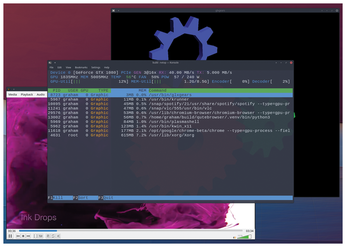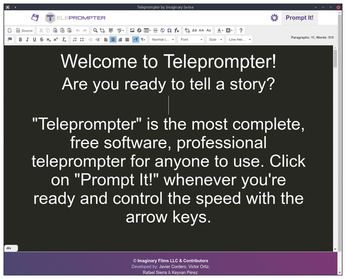FOSSPicks
nvtop
Despite the NVidia graphics card being an essential part of many Linux setups, especially if you're into virtual reality (VR), gaming, or machine learning, there isn't much in the way of third-party (or first-party!) support. NVidia X Server Settings is about as good as it gets. With the proprietary drivers installed, the hardware is often left simply to find its own way, whether that's accelerating polygons with OpenGL or autonomous truth matrices with OpenCL. The first sign of anything going awry is likely to be the airplane sound of your GPU fans as they attempt to cool some wayward GPU-bound process. If the GPU was a CPU, you'd use a tool like top, or htop. Now with NVidia's hardware, you can use nvtop.
nvtop is a task monitor for your graphics hardware. Much like the CPU variants, it shows you the type of application, the amount and percentage of memory it's using, and the command used to launch the process. A global section also displays details about your specific hardware, such as the model, PCI speed, GPU frequency, transfer rates, power, temperature, and fan. A couple of brilliant charts show percentage usage for raw processing power, memory, and encoding and decoding, as well. Many of these elements are dynamic and will change as your GPU experiences periods of load. It provides a fascinating insight into something not often considered, but if you're using your GPU for work or serious gaming, it's also essential because you can see which processes are stealing precious cycles and affecting your performance. You can then kill them directly from within the text-based UI. It's all you need for GPU management. If you have an NVidia GPU, this is a tool that will quickly become an essential build and install on any system on which you rely.
Project Website
https://github.com/Syllo/nvtop

Teleprompter
Imaginary Teleprompter
A teleprompter is often associated with that awkward wide-angle shot of live television, where the presenter is looking past the camera towards the large screen of text showing what to say. The teleprompter is usually showing a script for the presenter to speak, and it's been an important but specialized aspect of television production for decades. There initially seems little reason to look at an open source version, but YouTube has made all those old television techniques new again – from lighting to blue screens – and a teleprompter is a great way to help with narration and flow and takes the pressure off the presenter needing to remember everything to say.
Imaginary Teleprompter is one such teleprompter, and it looks and operates just like a word processor. You edit and format the text in exactly the same way, only you typically make the text very large. The main window lets you add images, create anchor points, add tables, and even add flash animations. A real-time update shows the number of paragraphs you've added, alongside the number of words. When you're happy with your copy, you click Prompt it, which opens a new pane that gives you the option to flip the screen, use an external prompter, change the style from the standard blackboard, and set the focus area. The focus area is a narrow letterbox through which the text scrolls – like a window – allowing the presenter to see what's coming and can then get ahead of the focus point or behind, depending on the presenter's style and the context of the talk. As you'd expect, you can also change the scroll speed, as well as the font scale and acceleration curve. A timer also shows you how long you're taking. It all works absolutely brilliantly and could easily make the difference between your YouTube channel being full of clumsy reviews and a professional channel that's far more likely to attract viewers and sponsors.
Project Website
https://snapcraft.io/imaginary-teleprompter

Buy this article as PDF
(incl. VAT)
Buy Linux Magazine
Subscribe to our Linux Newsletters
Find Linux and Open Source Jobs
Subscribe to our ADMIN Newsletters
Support Our Work
Linux Magazine content is made possible with support from readers like you. Please consider contributing when you’ve found an article to be beneficial.

News
-
TUXEDO Computers Unveils Linux Laptop Featuring AMD Ryzen CPU
This latest release is the first laptop to include the new CPU from Ryzen and Linux preinstalled.
-
XZ Gets the All-Clear
The back door xz vulnerability has been officially reverted for Fedora 40 and versions 38 and 39 were never affected.
-
Canonical Collaborates with Qualcomm on New Venture
This new joint effort is geared toward bringing Ubuntu and Ubuntu Core to Qualcomm-powered devices.
-
Kodi 21.0 Open-Source Entertainment Hub Released
After a year of development, the award-winning Kodi cross-platform, media center software is now available with many new additions and improvements.
-
Linux Usage Increases in Two Key Areas
If market share is your thing, you'll be happy to know that Linux is on the rise in two areas that, if they keep climbing, could have serious meaning for Linux's future.
-
Vulnerability Discovered in xz Libraries
An urgent alert for Fedora 40 has been posted and users should pay attention.
-
Canonical Bumps LTS Support to 12 years
If you're worried that your Ubuntu LTS release won't be supported long enough to last, Canonical has a surprise for you in the form of 12 years of security coverage.
-
Fedora 40 Beta Released Soon
With the official release of Fedora 40 coming in April, it's almost time to download the beta and see what's new.
-
New Pentesting Distribution to Compete with Kali Linux
SnoopGod is now available for your testing needs
-
Juno Computers Launches Another Linux Laptop
If you're looking for a powerhouse laptop that runs Ubuntu, the Juno Computers Neptune 17 v6 should be on your radar.

